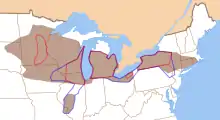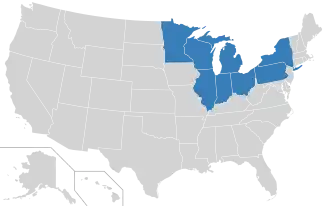Northern American English
Northern American English or Northern U.S. English (also, Northern AmE) is a class of historically related American English dialects, spoken by predominantly white Americans,[1] best documented in the greater metropolitan areas of Connecticut, Western Massachusetts, Western and Central New York, Northern Ohio, Northern Illinois, Wisconsin, the Lower Peninsula of Michigan, and Eastern South Dakota, plus Northern New Jersey, Northeastern Pennsylvania, Iowa, Minnesota, and Wisconsin.[2] The North as a super-dialect region is considered, by the 2006 Atlas of North American English (ANAE), at its core, to consist of the dialects of the Inland North (the eastern Great Lakes region) and Southwestern New England.[3]
| Northern American English | |
|---|---|
| Northern U.S. English | |
| Region | Northern United States |
| Language codes | |
| ISO 639-3 | – |
| Glottolog | nort3316 |
 21st-century research unites the whole grey-brown region of this map as a Northern U.S. super-dialect region. Notice that the Northwest and much of New England are not included. | |
Northern U.S. accents are often distinguished from Southern U.S. accents by retaining /aɪ/ as a diphthong (unlike the South, which commonly monophthongizes this sound) and from Western U.S. accents and Canadian accents by mostly preserving the distinction between the /ɑ/ and /ɔ/ sounds in words like cot versus caught (except in the transitional dialect region of the Upper Midwest and variably in other Northern areas, especially among younger Americans).[4] However, Canadian English likely originated from Northern U.S. English.[5][6] Though arguably native to the geographical Northern United States, current-day Northwestern U.S.,[nb 1] New York City, and Eastern New England accents do not fit under the Northern U.S. accent spectrum, or only marginally; according to the ANAE, they each have one or more characteristics that disqualifies them.
The Inland Northern speech of the very early 20th century was the basis for the term "General American", though a new regional accent has since developed in that area.[7][8]
Phonology
In the modern day, the Northern United States is a linguistic super-region of English dialects, defined by /oʊ/ (as in goat, toe, show, etc.) and traditionally /u/ (as in goose, too, shoe, etc.) pronounced conservatively far in the back of the mouth, "r-fulness" (or rhoticity), and a common lack of the cot–caught merger, meaning that words like pond and pawned, or bot and bought, are not pronounced identically (with the second of this class of words being pronounced usually farther back in the mouth and with more rounded lips).
The Northern Cities Vowel Shift is a series of sound changes in the North that covers a large area from western New England and New York to regions west of Wisconsin.[9]
A phenomenon known as "Canadian raising"—the lifting of the body of the tongue in both /aɪ/ and /aʊ/ before voiceless consonants (therefore, in words, like height, slight, advice, clout, ouch, lout, etc., but not in words like hide, slide, advise, cloud, gouge, loud, etc.)—is common in eastern New England, for example in Boston (and the traditional accent of Martha's Vineyard), as well as in the Upper Midwest. Raising of just /aɪ/ is found throughout the entire North, including in the Great Lakes area,[10] and elsewhere in New England.[11] This second, more focused type of raising also appears to spreading beyond the North, as well as to California English, Philadelphia English, and Western American English dialects overall.[12]
Though the following pronunciation variants are not all the most common ones in the North, they are still documented as variants used more strongly in this region than anywhere else in the country:[13]
- been as /bɛn/ (a homophone with the name Ben)
- crayon as the single-syllable /kræn/ (often [kʰɹɛən])
- pajamas as /pəˈdʒæməz/ (in addition to /pəˈdʒɑməz/ more widely common nationwide)
- handkerchief rhyming with beef
- poem as the single-syllable /poʊm/, rhyming with dome
- root and roof using the FOOT vowel [ʊ] (
 listen) as a somewhat common alternative to the typical GOOSE vowel [u] (
listen) as a somewhat common alternative to the typical GOOSE vowel [u] ( listen)[14]
listen)[14]
Declining characteristics
The North has historically been one of the last U.S. regions to maintain the distinction between /ɔr/ and /oʊr/, in which words like horse and hoarse or war and wore, for example, are not homophones;[15] however, the merger of the two has quickly spread throughout the North. The KIT vowel [ɪ] (![]() listen) was once a common Northern U.S. sound in the word creek, but this has largely given way to the FLEECE vowel [i] (
listen) was once a common Northern U.S. sound in the word creek, but this has largely given way to the FLEECE vowel [i] (![]() listen), as in the rest of the country.[16]
listen), as in the rest of the country.[16]
Vocabulary
The North is reported as uniquely or most strongly using certain words:[13]
- babushka (a woman's headscarf, tied under the chin)[17]
- bare-naked (synonym for naked)[18]
- crayfish (a freshwater lobster-like crustacean)
- crust (the end of a bread loaf)
- diagonal or kitty-corner (situated slanted across a street or intersection)
- doing cookies (rare synonym, scattered throughout the North, for doing doughnuts)
- frosting (synonym for icing)
- futz or futz around (/fʌts/; to fool around or waste time)[19]
- garbage (synonym for trash)[20]
- on the fritz (out of order, or into a state of disrepair)[21]
- pit (the seed or stone of a fruit)[22]
- you guys (the usual plural form of you)
Northeastern American English

A Northeastern Corridor of the United States follows the Atlantic coast, comprising all of New England, Greater New York City, and Greater Philadelphia (including adjacent areas of New Jersey), sometimes even classified as extending to Greater Baltimore and Washington D.C. This region, despite being home to numerous different dialects and accents, constitutes a huge area unified in certain linguistic respects, including particular notable vocabulary and phonemic incidence (that is, basic units of sound that can distinguish certain words).
Phonology
These phonemic variants in certain words are particularly correlated with the American Northeast (with the more common variants nationwide given in parentheses):[13]
- aunt as /ɑnt/ (in addition to /ænt/)
- cauliflower with the "i" pronounced with the FLEECE vowel /i/ (in addition to the KIT vowel /ɪ/)
- centaur rhyming with four (in addition to the variant rhyming with far)
- miracle as /ˈmɛrəkəl/ or /ˈmirəkəl/ (in addition to /ˈmɪrəkəl/)
- route rhyming with shoot (in addition to shout)
- syrup as /ˈsirəp/ or /ˈsɪrəp/ (in addition to /ˈsɜrəp/)
The Northeast tends to retain a rounded /ɔ/ vowel (in words like all, caught, flaw, loss, thought, etc.): specifically, this is realized as [ɒ~ɔə].
Vocabulary
Terms common or even usual to the whole Northeast include:[13]
- brook (synonym for stream)[23]
- cellar (synonym for basement)
- cruller (a stick-like doughnut)
- goose pimples (synonym for goose bumps),
- elastic, hair elastic, or hair thing (synonyms for hair tie)
- papering or TP'ing (synonym for toilet papering)
- rotary (synonym for traffic circle)
- sneakers (any athletic shoes)
- soda (any sweet, carbonated soft drink)
- stoop (small outdoor staircase to a building's front door)
- sunshower (a sunny rainshower)
- tractor trailer (a semi-trailer truck)
Inland Northern American English

The recent Northern cities vowel shift, beginning only in the twentieth century, now affects much of the North away from the Atlantic coast, occurring specifically at its geographic center: the Great Lakes region. It is therefore a defining feature of the Inland North dialect (most notably spoken in Chicago, Detroit, and western New York State). The vowel shift's generating conditions are also present in some Western New England English;[24] otherwise, however, this vowel shift is not occurring in the Northeastern United States.
Notes
- It is arguable whether or not the Pacific Northwest dialect region falls under the Northern super-dialect region. In American linguistics, "North" typically only refers to the "traditional North": the Northeastern and North Central States, while excluding the Northwestern States.
References
- Purnell, Thomas; Eric Raimy; and Joseph Salmons (eds.) (2013). Wisconsin talk: Linguistic diversity in the Badger State. University of Wisconsin Press. p. 109.
- Labov, William; Sharon Ash, Charles Boberg (2006). The Atlas of North American English. Berlin: Mouton de Gruyter. p. 134.
- Labov, William; Sharon Ash, Charles Boberg (2006). The Atlas of North American English. Berlin: Mouton de Gruyter. p. 148.
- Labov, William; Sharon Ash, Charles Boberg (2006). The Atlas of North American English. Berlin: Mouton de Gruyter. p. 133.
- "Canadian English". Brinton, Laurel J., and Fee, Marjery, ed. (2005). Ch. 12. in The Cambridge history of the English language. Volume VI: English in North America., Algeo, John, ed., pp. 422–440. Cambridge, UK: Cambridge University Press, 1992. ISBN 0-521-26479-0, 978-0-521-26479-2. On p. 422: "It is now generally agreed that Canadian English originated as a variant of northern American English (the speech of New England, New York, New Jersey, and Pennsylvania)".
- "Canadian English". McArthur, T., ed. (2005). Concise Oxford companion to the English language, pp. 96–102. Oxford, UK: Oxford University Press. ISBN 0-19-280637-8. On p. 97: "Because CanE and AmE are so alike, some scholars have argued that in linguistic terms Canadian English is no more or less than a variety of (Northern) American English".
- Labov et al., p. 190.
- "Talking the Tawk", The New Yorker
- McCarthy, Natalie (2004). THE NORTHERN CITIES SHIFT AND LOCAL IDENTITY IN A SUBURBAN CLEVELAND GROUP (PDF). p. 7.
- Schneider (2008:81)
- Schneider (2008:389)
- A Handbook of Varieties of English, Bernd Kortmann & Edgar W. Schneider, Walter de Gruyter, 2004, p. 359.
- Vaux, Bert and Scott Golder. 2003. The Harvard Dialect Survey. Cambridge, MA: Harvard University Linguistics Department.
- Schneider (2008:80)
- Schneider (2008:81)
- Schneider (2008:80)
- "Babushka". Dictionary of American Regional English. 2017.
- "Bare-naked". The American Heritage Dictionary of the English Language, Fifth Edition. 2017. Houghton Mifflin Harcourt Publishing Company.
- "Futz". Dictionary of American Regional English. 2017.
- Grive, Jack; Asnaghi Costanza (2013). "A lexical dialect survey of American English using site-restricted web searches". ADS Annual Meeting, Boston. Ashton University and University of Leuven.
- "On the fritz". Dictionary of American Regional English. 2017.
- "Pit". Word Reference. Word Reference. 2017.
- "Brook" and "Runs". The American Heritage Dictionary of the English Language, Fifth Edition. 2017. Houghton Mifflin Harcourt Publishing Company.
- Labov, William; Ash, Sharon; Boberg, Charles (1997). "Dialects of the United States." A National Map of The Regional Dialects of American English. University of Pennsylvania.
- Schneider, Edgar (2008). Varieties of English: The Americas and the Caribbean. Walter de Gruyter. ISBN 9783110208405.